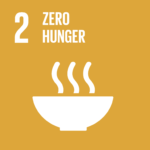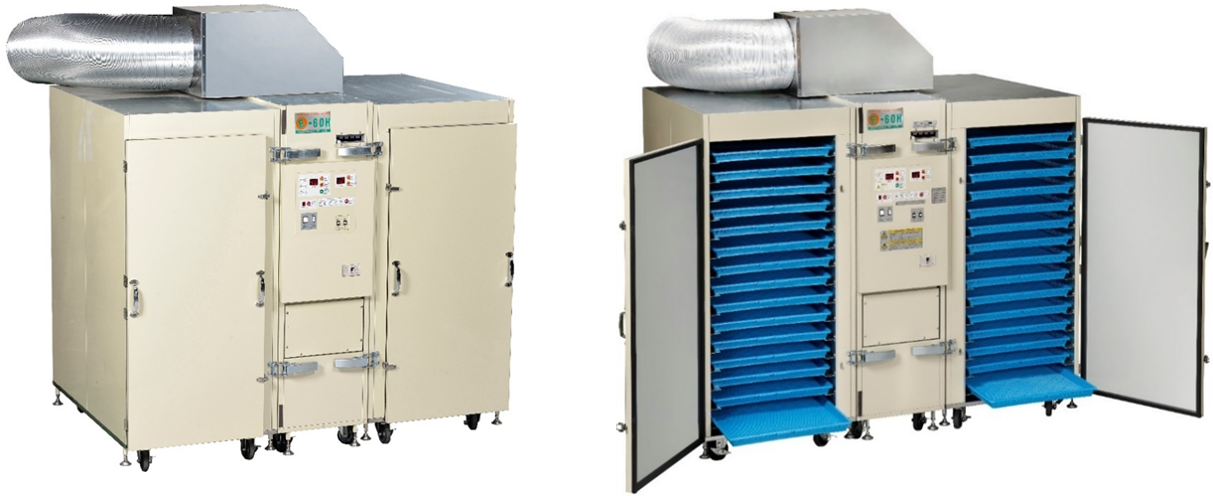Eco-friendly with Zero CO2, 

Safe and Secure Electric Dryer
for Food Processing
TAIKI SANGYO CO., LTD. is a top manufacturer of food dryers with a market share of over 30% in Japan, making it easy to produce dried vegetables and fruits. The industry's first commercial electric dryer, developed in 2008, was a huge hit because of its two innovative features: safe and efficient operation derived from electric type, and availability to household power supply.
Non-specified agricultural products such as wounds and deformation can be reborn as dry products instead of being discarded, triggering the lineup of dry products at direct sales outlets of agricultural products throughout Japan. In particular, large electric dryers that exceed 100 kg in one batch are the only products that have no competitive products in Japan.

Fig. 1 Electric food dryers manufactured by TAIKI SANGYO CO., LTD.(Photo of E-60H-ADP)
Product video:
Product catalogue: https://www.taikisangyo.co.jp/renewal/taiki_img/pdf/en_catalogue-food-dryer.pdf
Major Features and Advantages
The greater volume a dryer has in one batch, the more difficult drying process will become. Our technology saves power and ensures uniform drying. In addition, even if a power outage occurs, the original control algorithm automatically restores the program just before the power outage is stored. This sequence is printed into circuit boards. In particular, large dryers with a throughput of over 100 kg boast the largest among electric dryers in Japan. Electric dryers have many advantages over boiler dryers that use kerosene or gas as a heat source; zero CO2 emissions with electricity derived from renewable energy, low running costs, no periodic maintenance and significantly fewer failures.
In order to increase the income of agricultural producers around the world and, spread safe and secure dried foods, the JICA project is currently adopted as a business model that simultaneously supports poverty eradication in rural areas in developing countries and expands overseas sales channels. We are working on a step. A major feature is the technology of drying while retaining the original color of the material. Especially in developing countries where cold chains are underdeveloped, and the climate is hot and humid, agricultural products are easily perishable. That is why the demand of our electric dryers is high.
Technology Data
Possible applications
Our electric dryer has many advantages compared to a dryer using oil as a heat source, such as zero CO2 emission, low running cost, no regular maintenance, and much less failures than a dryer using oil.
Currently, the JICA project is working on a business model to simultaneously support poverty eradication in rural areas of developing countries, to expand overseas sales channels in order to increase the income of agricultural producers around the world, and to spread safe and secure dried foods. A major feature is the technology of drying while retaining the color of the material. Especially in developing countries where the cold chain is underdeveloped and hot and humid, agricultural products are liable to perish and the need for our electric dryer is high. In particular, large electric dryers with throughputs exceeding 100 kg/cicle are only one of our products in Japan.
Processing work using an electric dryer is a light work load that can be performed by women.
The flow of the processing step is washing → slicing → drying → packaging. There is a possibility that women are able to complete everything from production to sales by themselves, which can contribute to creating employment opportunities and raising income for rural women. In fact, in Africa Sudan, with the support of JICA, we have supplied our electric dryers. A local women’s union makes dried onions from production to sale by only women workers.
Competitive advantage
Competing manufacturers are Chinese and Korean products. Compared to our electric dryers, products from the two countries have by 20 to 40% less air volume for the internal circulation (see Fig. 2). Therefore, there is drying unevenness, and the amount of discharged water is small. As overseas products take about 20% extra drying time, our electric dryers can advantageously reduce power consumption by about 20%.
In Japan, there are not so many competitive dryers from which Taiki Sangyo is trying to differentiate ourselves. Compared with boiler dryers using kerosene or gas burners as a heat source, electric dryers do not require a chimney and have no waste heat loss. Major feature electric dryers are that there is no maintenance and there are few failures.
Performance

Fig. 3 Scheme of food drying in TAIKI SANGYO’s products
Electricity: Single phase 100V/ Three phase 200V
※A separate power transformer is required for use outside of Japan.
Power: 517~37,105W
Processing volume at one batch: 2~240kg ※before drying
Body material: stainless steel (SUS304) or iron
Table. 1 and 2 show standard drying tables when using our electric food dryers. Drying temperature and time are just examples, it may depend on the quantity of trays and sickness of foods. Please record the real data and create your own table.
Table. 1 Drying temperature of vegetable

Table2. Drying temperature of fruits

Technical maturity / Past record of introduction
The company has been participating in JICA’s verification survey projects in Sudan (see Fig. 4).
Through this project, TAIKI SANGYO has installed total 30 units. (7 units of JICA project and 23 units of Japanese ODA project by Ministry of Foreign Affairs)
 Fig. 4 JICA Project scheme in Sudan
Fig. 4 JICA Project scheme in Sudan
Other than projects in Sudan, food dyers have been sold to ASEAN countries, Sri Lanka and USA for drying of various products.
Corporate website: https://www.taikisangyo.co.jp/English/en_expansion/
Table 3. Overseas delivery results of electric dryers (last 3years)

Information on patent related to this technology
REGISTRATION OF DESIGNS
Japanese patent
No.1496123
No.1496124
Company Data
| Name | TAIKI SANGYO CO., LTD. |
| Address | 3-3 Seishin-cho, Kita-ku, Okayama-shi, Okayama,700-0027 Japan |
| Capital | 20 million JPY (as of December 2019) |
| Contact person |
Mr. Soichiro YASUHARA |
| Number of employees | 28 (as of December 2019) |
| Date of company foundation | 15 January, 1948 |
| The type of business |
Agricultural machinery manufacturing |
International operation
| Number of employees for international operation |
3 | |
| Overseas offices |
City, Country | Name of Company (if applicable) |
| N/A | N/A | |
Modality of business transaction
Export of product
Electric dryers are characterized by no regular maintenance and fewer failures. We have created dryer operation and troubleshooting manuals, and trained engineers not only in Asia but also in Africa.
Attachments
Schematic illustration of the technology
The examples and models of drying process for vegetables and fruits
Table of drying temperature-1
Table of drying temperature-2
Contact Person(s)
*Please mention that you saw UNIDO's website when making the first contact with the company.
Registered Category
- Agribusiness Technologies : Food value chain


